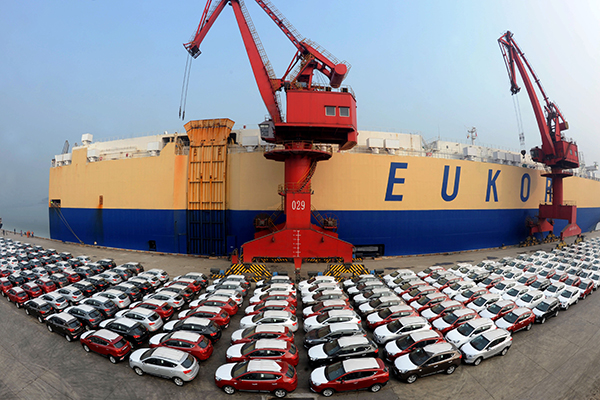 |
|
Rows of Chinese automobiles are lined up in Lianyungang Port, Jiangsu province, in January, waiting to be shipped to Brazil. [Photo/China Daily] |
Global instability and terrorism threats have constrained automobile trade
China's automobile exports tumbled in the first half of this year amid the uncertain international trade environment, although the domestic market was stimulated by the new purchase tax deduction policy and industry insiders expect a further ramping up of the Chinese auto market.
The automobile industry registered an export revenue decline of 5.6 percent year-on-year in June, while the domestic market moved 14.6 percent more vehicles to register 2.1 million units.
The shipment of vehicles and chassis in the first six months totaled about 340,000 units, 10.8 percent fewer than in the first half of last year. Vehicles, chassis and auto parts brought in a total of $27 billion, a fall of 6.3 percent on last year's figure, according to statistics released Wednesday by the General Administration of Customs.
Commercial vehicle exports slumped by 33.4 percent in the first half of the year to around 114,000 units, while passenger car exports dipped by 6.5 percent to about 200,000 units, according to the China Association of Automobile Manufacturers.
Unstable regional geopolitical situations and terrorism threats are the factors that are constraining automobile exports and hindering the confidence of investors, said Yao Jie, CAAM's deputy secretary-general.
Another deputy secretary-general of CAAM, Shi Jianhua, commented that it will take time for China to develop from a large car market to a strong auto power.
He said: "Chinese carmakers' products need to meet the local demands in destination markets in order address the fact that their products don't sell in the international market.
"If they (Chinese car makers) can grasp a 20 to 30 percent share in the international market, then we can say the industry has matured."
CAAM found that Latin America, Eastern Europe and Southeast Asia were the major automobile export destinations, continuing last year's distribution pattern.
Research by Deloitte Consulting showed that Iran was the leading destination for Chinese vehicles last year, accounting for 14 percent of the country's auto exports. This was followed by 10 percent to Vietnam, and 5 percent to Egypt, Chile, and Venezuela respectively.
The negative knock-on effects were largely the result of the economic slow-down, weak consumer demand for new cars, and lack of organic growth momentum, stated the United Kingdom headquartered firm's report released in June.
Many Chinese carmakers opted to build factories abroad to reduce export costs due to the host countries' import tariff, non-tariff barriers, and drastic currency fluctuations, according to Deloitte. Procurement and manufacture abroad contributes less to China's export development, but it does accelerate the growth of the country's gross national product and foreign exchange reserves.
State-owned BAIC International Development Co is building the only Chinese automotive plant in Mexico, which is set to start producing vehicles locally in 2017.
Commenting on the overall global situation, Huang Songping, spokesman of the General Administration of Customs said: "The global economic environment could be more complicated in the future, and uncertainty could influence China's international trade."
Policy driven growth
In contrast to the export situation, China's domestic market achieved higher than expected growth for both June and the first half of the year. However, CAAM maintained its 6 percent annual growth rate prediction for market volume this year.
Nationwide vehicle deliveries jumped 8.14 percent year-on-year to 12.8 million units from January to June, and this was accompanied by a 9.23 percent rise in the volume of passenger car sales to 11 million units.
Such rises are the result of the favorable taxation policy introduced last year, according to the association. Chen Shihua, assistant to the secretary-general of CAAM, told a news conference in Beijing on June 11 that the significant sales rise in the first half was triggered by the sales tax reduction policy launched last October, as part of the country's drive to promote low-emission vehicles.
The market has seen solid expansion since last October, following the halving of purchase tax to 5 percent on vehicles with an engine capacity of 1.6-liter or smaller.
The policy is a potential windfall for customers and could save them thousands of yuan. Take the most popular passenger car model in the first half, Wuling Hongguang, as an example: Thanks to the policy, the buyer pays between 1,786 yuan ($267) and 3,388 yuan less tax on the multi-purpose vehicle that has a suggested retail price starting at 41,800 yuan, rising to 79,300 yuan. The model registered about 294,300 units sales in the first half.
The sales tax reduction policy is set to be axed at the end of the year, despite the fact that it has been widely hailed as the industry's savior over the past nine months.
Chen said: "We called for an extension of the policy, but it is going to be linked with the overall national economy development. If the second half sees a positive overall situation, the policy might become unsustainable."
According to Yao, CAAM is progressively promoting a range of actions to encourage industry development and boost market growth.
Chinese auto market expansion was slowed after big city local governments sought to limit fuel-powered vehicle purchases in moves to curb both air pollution and urban congestion.
The association's data showed automobile sales volume totaled 24.6 million in China last year, up 4.7 percent year-on-year, marking the smallest increase in the past three years, following rises of 6.9 percent in 2014 and 13.9 percent in 2013.
